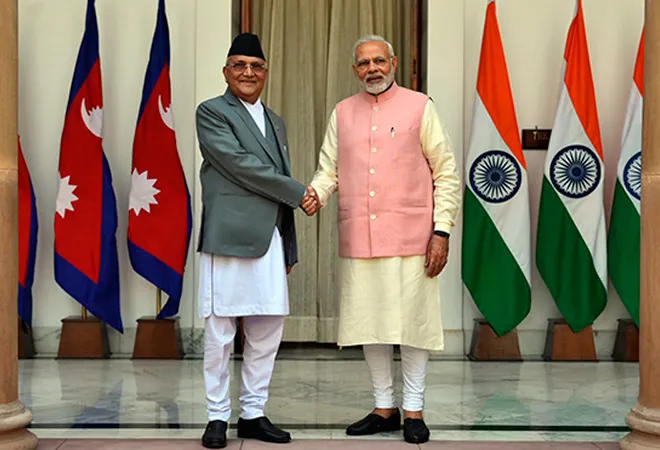The K. P. Oli government in Nepal has taken a drastic step of banning or blacking out all Indian private TV channels. It has, however, spared the Doordarshan, or DD, which is owned by the Indian government. The decision came as a counter to alleged ‘offensive character assassination’ by the Indian media of Nepali citizens and leaders, thereby hurting their sentiments and being disrespectful of Nepalese sovereignty. Nepalese Minister of Communication and Information Technology, Yubaraj Khatiwada, spoke about such allegations and the legal and political steps being planned against any such unpleasant presentation.
The Embassy of Nepal in New Delhi also sent a diplomatic note verbale to the Ministry of External Affairs, expressing their dissent over the issue. Naturally, this entire scenario has not gone too well with the Indian government, though a formal response is still due. Nevertheless, a large section of the Indian media as well as many leaders have clearly stated that such a step might be extremely harmful for the already fragile bilateral relationship of the countries in the future along with questions on the freedom of press. Diplomatic circles in India have also claimed that this decision was extremely hasty in nature, where the government of Nepal could have first talked to the particular channel concerned, rather than taking it up with the Indian Ministry of External Affairs (MEA), as both the countries remain embroiled in the Kalapani-Lipulekh border row.
Continued disharmony?
It is not unknown that the South Asian neighbours are going through a rough patch lately. There have been several debates and counter-debates regarding the placement of important and strategic locations like Limpiyadhura, Kalapani and Lipulekh, creating turmoil in the relationship, that has become sensitive since the year 2015 following the infamous border blockade. Both countries came out with their own versions of political maps claiming the aforementioned places to be within their own territories. In such a situation, the media has been covering the issue with the involvement of external factors like the presence of China and the rapport it shares with Nepal, much to the dismay of India.
In fact, the recent confrontation between India and China in the Galwan Valley was also connected with this issue. The Indian media reports of China occupying certain territories of Nepal were negated by the Nepali leadership. Even though Kathmandu saw mass protests and a petition was filed by the opposition MPs belonging to the Nepali Congress, the government position did not see any change.
It also appears that all is not well within the ruling Nepal Communist Party (NCP). For the past few months, there have been reports of rift between Prime Minister K. P. Oli and party chairman Pushpa Kamal Dahal, better known as Prachanda. Allegations have been levelled against PM Oli’s behaviour which has not gone down too well with Dahal, who has sought Oli’s resignation.
Besides the personal differences between Oli and Dahal, there are also reports of divide on the ideological framework of the ruling NCP. It came out in the media that Oli had been apprehensive of being ‘dislodged’ or ‘unseated’ from the position of Prime Minister with the help of the Indian government. This has raised several eyebrows in both countries.
Given the complex nature of South Asian politics, spilling the beans during a crisis situation like the Covid-19 might not have been a wise decision on Oli’s part. This is all the more true because both India and Nepal are working closely to tackle this issue with the bigger power helping the small Himalayan nation to keep its health infrastructure on the right track.
Replay from the past
This is not the first time that Indian channels were blocked or banned in Nepal. The latest was in the 2015 crisis, when the Indo-Nepal ties had hit the rock bottom following the blockade. Even today, there lie the undercurrents of dissatisfaction among the Nepalese because this was nothing short of a humanitarian crisis with lack of food supplies and essentials after the devastating earthquake. The ban on Indian media, which also included entertainment channels -- quite popular in Nepal – was for an indefinite period then.
This was also the time Nepal had adopted its new Constitution and India had expressed concern and protests of minority ethnic groups were taking place in the south of Nepal. However, both the countries evolved from this situation with the passage of time, helped by the memories of historical bonhomie and geographical contiguity.
Now we are living in trying times. Economic crisis may be knocking on our door in the post Covid-19 world. Tension in the relationship of the countries might create trouble for the people who cross the open border every day for survival through various economic ventures. So, both countries should realise their importance in each other’s books for not only harnessing the maximum potential of South Asian opportunities but also for living in peace. To facilitate this, the Nepal PM should utilise the diplomatic channel and keep away from knee-jerk reactions like the ban on India TV channels.
This commentary originally appeared in South Asia Weekly.
The views expressed above belong to the author(s). ORF research and analyses now available on Telegram! Click here to access our curated content — blogs, longforms and interviews.




 PREV
PREV


